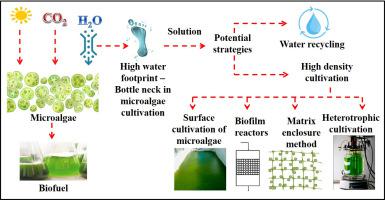Science of the Total Environment ( IF 9.8 ) Pub Date : 2020-09-13 , DOI: 10.1016/j.scitotenv.2020.142218 Arivalagan Pugazhendhi , Senthil Nagappan , Rahul R. Bhosale , Pei-Chien Tsai , Shakunthala Natarajan , Saravanan Devendran , Lamya Al-Haj , Vinoth Kumar Ponnusamy , Gopalakrishnan Kumar

|
Due to their rapid growth rates, high lipid productivity, and ability to synthesize value-added products, microalgae are considered as the potential biofuel feedstocks. However, among the several bottlenecks that are hindering the commercialization of microalgal biofuel synthesis, the issue of high water consumption is the least explored. This analysis, therefore, examines the factors that decide water use for the production of microalgae biofuel. Microalgae biodiesel water footprint varies from 3.5 to 3726 kg of water per kg of biodiesel. The study further investigates the cause for large variability in the estimation of the water footprint for microalgae fuel. Various strategies, including the reuse of harvested water, the use of high density cultivation that could be adopted for low water consumption in microalgal biofuel production are discussed. Specifically, the review identified a reciprocal relationship between biomass productivity and water footprint. On the basis of which the review emphasizes the significance of high density cultivation, which can be inexpensive and feasible relative to other water-saving techniques. With the setback of water scarcity due to the rapid industrialization in developing countries, the implementation of the cultivation system with a focus on minimizing the water consumption is inevitable for a successful large scale microalgal biofuel production.


























 京公网安备 11010802027423号
京公网安备 11010802027423号